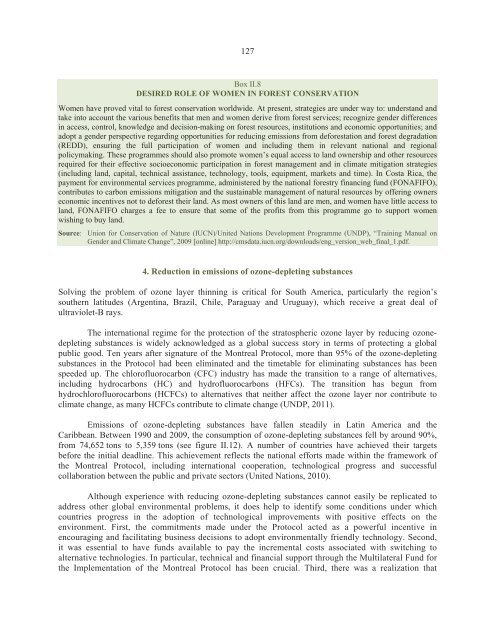sustainable development 20 years on from the ... - José Eli da Veiga
sustainable development 20 years on from the ... - José Eli da Veiga
sustainable development 20 years on from the ... - José Eli da Veiga
You also want an ePaper? Increase the reach of your titles
YUMPU automatically turns print PDFs into web optimized ePapers that Google loves.
127<br />
Box II.8<br />
DESIRED ROLE OF WOMEN IN FOREST CONSERVATION<br />
Women have proved vital to forest c<strong>on</strong>servati<strong>on</strong> worldwide. At present, strategies are under way to: understand and<br />
take into account <strong>the</strong> various benefits that men and women derive <strong>from</strong> forest services; recognize gender differences<br />
in access, c<strong>on</strong>trol, knowledge and decisi<strong>on</strong>-making <strong>on</strong> forest resources, instituti<strong>on</strong>s and ec<strong>on</strong>omic opportunities; and<br />
adopt a gender perspective regarding opportunities for reducing emissi<strong>on</strong>s <strong>from</strong> deforestati<strong>on</strong> and forest degra<strong>da</strong>ti<strong>on</strong><br />
(REDD), ensuring <strong>the</strong> full participati<strong>on</strong> of women and including <strong>the</strong>m in relevant nati<strong>on</strong>al and regi<strong>on</strong>al<br />
policymaking. These programmes should also promote women’s equal access to land ownership and o<strong>the</strong>r resources<br />
required for <strong>the</strong>ir effective socioec<strong>on</strong>omic participati<strong>on</strong> in forest management and in climate mitigati<strong>on</strong> strategies<br />
(including land, capital, technical assistance, technology, tools, equipment, markets and time). In Costa Rica, <strong>the</strong><br />
payment for envir<strong>on</strong>mental services programme, administered by <strong>the</strong> nati<strong>on</strong>al forestry financing fund (FONAFIFO),<br />
c<strong>on</strong>tributes to carb<strong>on</strong> emissi<strong>on</strong>s mitigati<strong>on</strong> and <strong>the</strong> <str<strong>on</strong>g>sustainable</str<strong>on</strong>g> management of natural resources by offering owners<br />
ec<strong>on</strong>omic incentives not to deforest <strong>the</strong>ir land. As most owners of this land are men, and women have little access to<br />
land, FONAFIFO charges a fee to ensure that some of <strong>the</strong> profits <strong>from</strong> this programme go to support women<br />
wishing to buy land.<br />
Source: Uni<strong>on</strong> for C<strong>on</strong>servati<strong>on</strong> of Nature (IUCN)/United Nati<strong>on</strong>s Development Programme (UNDP), “Training Manual <strong>on</strong><br />
Gender and Climate Change”, <str<strong>on</strong>g>20</str<strong>on</strong>g>09 [<strong>on</strong>line] http://cms<strong>da</strong>ta.iucn.org/downloads/eng_versi<strong>on</strong>_web_final_1.pdf.<br />
4. Reducti<strong>on</strong> in emissi<strong>on</strong>s of oz<strong>on</strong>e-depleting substances<br />
Solving <strong>the</strong> problem of oz<strong>on</strong>e layer thinning is critical for South America, particularly <strong>the</strong> regi<strong>on</strong>’s<br />
sou<strong>the</strong>rn latitudes (Argentina, Brazil, Chile, Paraguay and Uruguay), which receive a great deal of<br />
ultraviolet-B rays.<br />
The internati<strong>on</strong>al regime for <strong>the</strong> protecti<strong>on</strong> of <strong>the</strong> stratospheric oz<strong>on</strong>e layer by reducing oz<strong>on</strong>edepleting<br />
substances is widely acknowledged as a global success story in terms of protecting a global<br />
public good. Ten <str<strong>on</strong>g>years</str<strong>on</strong>g> after signature of <strong>the</strong> M<strong>on</strong>treal Protocol, more than 95% of <strong>the</strong> oz<strong>on</strong>e-depleting<br />
substances in <strong>the</strong> Protocol had been eliminated and <strong>the</strong> timetable for eliminating substances has been<br />
speeded up. The chlorofluorocarb<strong>on</strong> (CFC) industry has made <strong>the</strong> transiti<strong>on</strong> to a range of alternatives,<br />
including hydrocarb<strong>on</strong>s (HC) and hydrofluorocarb<strong>on</strong>s (HFCs). The transiti<strong>on</strong> has begun <strong>from</strong><br />
hydrochlorofluorocarb<strong>on</strong>s (HCFCs) to alternatives that nei<strong>the</strong>r affect <strong>the</strong> oz<strong>on</strong>e layer nor c<strong>on</strong>tribute to<br />
climate change, as many HCFCs c<strong>on</strong>tribute to climate change (UNDP, <str<strong>on</strong>g>20</str<strong>on</strong>g>11).<br />
Emissi<strong>on</strong>s of oz<strong>on</strong>e-depleting substances have fallen steadily in Latin America and <strong>the</strong><br />
Caribbean. Between 1990 and <str<strong>on</strong>g>20</str<strong>on</strong>g>09, <strong>the</strong> c<strong>on</strong>sumpti<strong>on</strong> of oz<strong>on</strong>e-depleting substances fell by around 90%,<br />
<strong>from</strong> 74,652 t<strong>on</strong>s to 5,359 t<strong>on</strong>s (see figure II.12). A number of countries have achieved <strong>the</strong>ir targets<br />
before <strong>the</strong> initial deadline. This achievement reflects <strong>the</strong> nati<strong>on</strong>al efforts made within <strong>the</strong> framework of<br />
<strong>the</strong> M<strong>on</strong>treal Protocol, including internati<strong>on</strong>al cooperati<strong>on</strong>, technological progress and successful<br />
collaborati<strong>on</strong> between <strong>the</strong> public and private sectors (United Nati<strong>on</strong>s, <str<strong>on</strong>g>20</str<strong>on</strong>g>10).<br />
Although experience with reducing oz<strong>on</strong>e-depleting substances cannot easily be replicated to<br />
address o<strong>the</strong>r global envir<strong>on</strong>mental problems, it does help to identify some c<strong>on</strong>diti<strong>on</strong>s under which<br />
countries progress in <strong>the</strong> adopti<strong>on</strong> of technological improvements with positive effects <strong>on</strong> <strong>the</strong><br />
envir<strong>on</strong>ment. First, <strong>the</strong> commitments made under <strong>the</strong> Protocol acted as a powerful incentive in<br />
encouraging and facilitating business decisi<strong>on</strong>s to adopt envir<strong>on</strong>mentally friendly technology. Sec<strong>on</strong>d,<br />
it was essential to have funds available to pay <strong>the</strong> incremental costs associated with switching to<br />
alternative technologies. In particular, technical and financial support through <strong>the</strong> Multilateral Fund for<br />
<strong>the</strong> Implementati<strong>on</strong> of <strong>the</strong> M<strong>on</strong>treal Protocol has been crucial. Third, <strong>the</strong>re was a realizati<strong>on</strong> that













